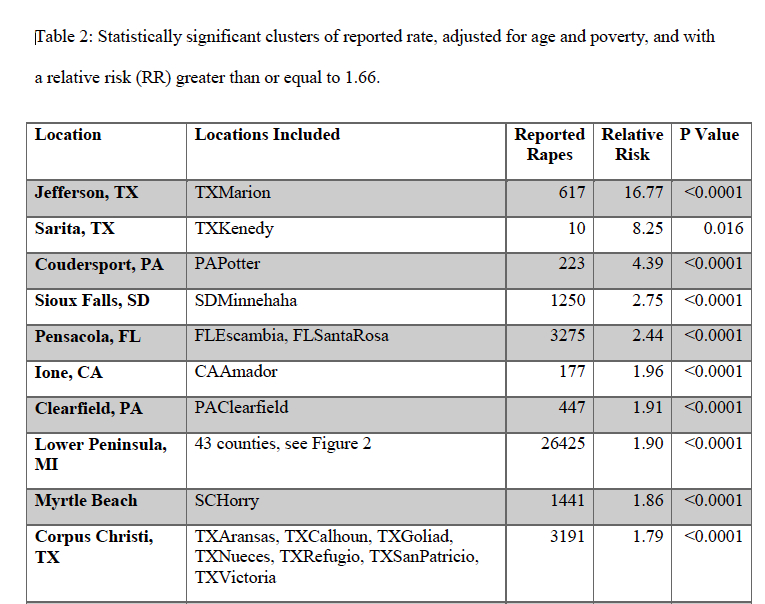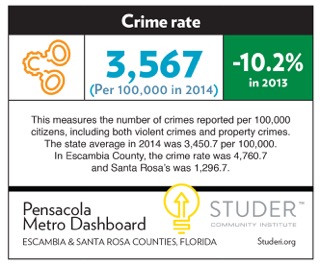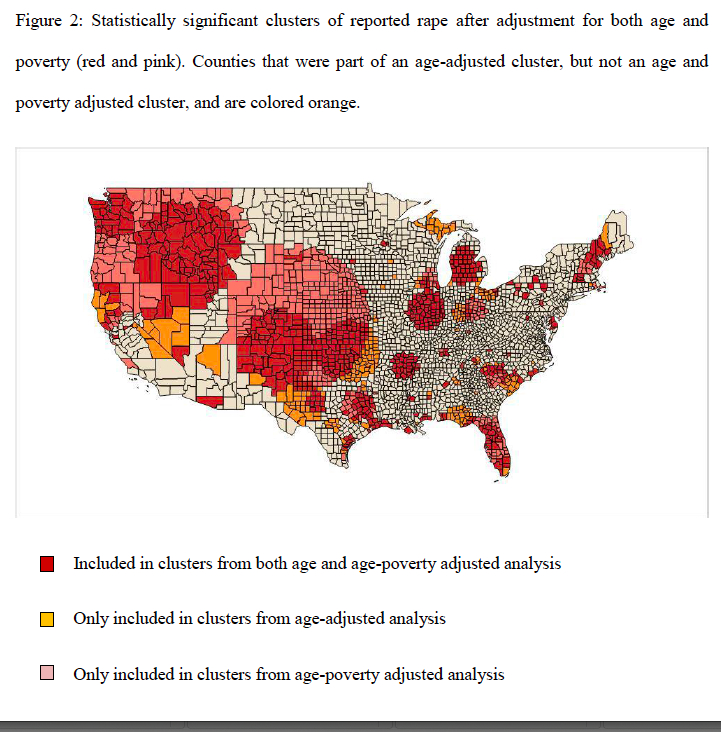Where is Pensacola on the reported sexual assault map?
- September 29, 2015
- / Shannon Nickinson
- / community-dashboard

A group of researchers from the University of West Florida mapped reported sexual assaults across the continental United States to see if some areas showed higher incidences of these crimes.
They did find areas where reported sexual assault reports were more prevalent. And one of them was the Escambia and Santa Rosa county area. When the data is adjusted for poverty and age, the Pensacola metro area is fifth in the country for an elevated risk of reported sexual assault.
“When we look at sources affecting rape that are not associated with demographics (not age or poverty or any factors related to these two), there’s something else. I don’t know but it needs work,” said UWF mathematics Professor Raid Amin, who with Martin Kulldorff of Harvard University, did most of the modeling and structuring with the project. "It is a sobering result."
The group used data from the Uniform Crime Report — the annual report of crime in a community used by the Federal Bureau of Investigation and state agencies such as the Florida Department of Law Enforcement as a measure of public safety.
Crime rate is one of 16 metrics the Studer Community Institute uses in the
Pensacola Metro Dashboard as a snapshot of the community’s quality of life. Developed in consultation with the UWF Office of Economic Development and Engagement, the dashboard is a snapshot of the educational, economic and social well-being of a community.Amin and Kulldorff were supported in the work by Nicole Nabors, Arlene Nelson and Murshid Saqlain, who were UWF students when the project began in 2010. Amin said it developed into a much deeper project over the past five years, and other individuals joined as research collaborators.
Their study was accepted for publication in August online by the journal Statistics and Public Policy.
It is linked here.
Escambia County is seeing an uptick in the crime rate — and in sexual assaults — at the six-month mark in data collection. Data from the Sheriff’s Office shows a 36 percent increase in reported forcible rapes for the first six months of 2015, compared to the first six months of 2014. Seventy-nine rapes were reported as of June 30; 58 were reported in 2014.
Pensacola Police Department data shows a 40 percent increase in reported forcible rapes for the first six months of 2015, compared to the first six months of 2014. Fourteen rapes were reported in the city limits in the first six months of 2015; 10 were reported in the same time frame in 2014. Read more here.
What the cluster study shows
Using data from 2001-2012 and software used to map diseases and how they spread, the group studied three questions:
— Are reported rape cases randomly distributed across the USA, after being adjusted?
for population density and age, or are there geographical clusters of reported rape cases?
— Are the geographical clusters of reported rapes still present after adjusting for differences in poverty levels?
— Are there geographical clusters where the proportion of reported rape cases that lead to an arrest is exceptionally low or exceptionally high?
“In disease surveillance, you first show spatially where the rates being studied are unusually high or low. The Health Department or (Environmental Protection Agency) could go in to look deeper to identify any causes,” Amin says. “That’s what I think this is.”
The study notes that areas where clusters are identified are “prime candidates for more intensive preventive counseling and criminal prosecution efforts by public health, social service, and law enforcement agencies.”
As the study notes, it is important to realize that the clusters can occur for various reasons.
“They would have to break down all the confidential data for each rape committed to look at commonalities,” Amin said. “What I do is the first step.”
For example, clusters of rape reports appear because there are many rapes in an area or because a high proportion of the rapes that do occur are reported to the police. The former is a bad thing while the latter is a good thing.
Considering the high relative risks for several of the clusters, we think that it is unlikely that differential reporting can explain more than at most a modest amount of the excess risk. For rape arrests, a cluster may occur either because of the number of rapes or because law enforcement agencies are successful at rape crime solving.
It is difficult to determine which results are driven by each of these factors; therefore, we did not conduct such an analysis.



 CivicCon launches with a look at good growth in cities
CivicCon launches with a look at good growth in cities
 Building stronger brains one baby, one parent at a time
Building stronger brains one baby, one parent at a time
 SCI debuts commercial on Early Learning City
SCI debuts commercial on Early Learning City
 Entrecon: World class speakers and an opportunity to sharpen skills
Entrecon: World class speakers and an opportunity to sharpen skills
 PYP Quality of Life survey 2017
PYP Quality of Life survey 2017
 EntreCon Pensacola 2016: A look back
EntreCon Pensacola 2016: A look back
 Leadership tip: getting better employee takeaways
Leadership tip: getting better employee takeaways
 Leadership tip: be interested instead of interesting
Leadership tip: be interested instead of interesting
 Leadership tip: delivering difficult messages
Leadership tip: delivering difficult messages
 Brain Bags boost Arc, Early Childhood Court programs
Brain Bags boost Arc, Early Childhood Court programs